M2 Pulver
M2 är ett höghastighetsstålpulver som kännetecknas av hög hårdhet och slitstyrka samt god seghet och tryckhållfasthet. Det används ofta inom additiv tillverkning av metall för att tillverka hållbara verktyg för skärning, formning och stansning.
Låg MOQ
Tillhandahålla låg minsta orderkvantitet för att möta olika behov.
OEM & ODM
Tillhandahålla kundanpassade produkter och designtjänster för att tillgodose unika kundbehov.
Tillräckligt lager
Säkerställa snabb orderhantering och tillhandahålla tillförlitlig och effektiv service.
Kundtillfredsställelse
Tillhandahålla högkvalitativa produkter med kundnöjdhet i fokus.
dela denna produkt
Innehållsförteckning
M2 är ett höghastighetsstålpulver som kännetecknas av hög hårdhet och slitstyrka samt god seghet och tryckhållfasthet. Det används ofta inom additiv tillverkning av metall för att tillverka hållbara verktyg för skärning, formning och stansning.
Sammansättning av M2-pulver
Sammansättningen av M2 höghastighetsstålpulver är:
| Element | Vikt % | Syfte |
|---|---|---|
| Volfram | 6.0 – 6.8 | Hårdhet, slitstyrka |
| Molybden | 4.8 – 5.5 | Tålighet, styrka |
| Krom | 3.8 – 4.5 | Härdning, slitstyrka |
| Vanadin | 1.9 – 2.2 | Härdning, slitstyrka |
| Kol | 0.78 – 0.88 | Härdning |
| Mangan | 0.15 – 0.45 | Härdning |
| Kisel | 0.15 – 0.45 | Desoxidationsmedel |
Den höga halten av volfram, molybden och krom ger utmärkt hårdhet och slitstyrka.
Egenskaper hos M2-pulver
Viktiga egenskaper hos M2-pulver inkluderar:
| Fastighet | Beskrivning |
|---|---|
| Hårdhet | 64 - 66 HRC vid värmebehandling |
| Slitstyrka | Utmärkt nötnings- och erosionsbeständighet |
| Tålighet | Högre än volframkarbidkvaliteter |
| Tryckhållfasthet | Upp till 300 ksi |
| Värmebeständighet | Kan användas upp till 600°C |
| Korrosionsbeständighet | Bättre än vanliga kolstål |
Egenskaperna gör M2 lämplig för hållbara verktyg för skärning, stansning och formning.
Parametrar för AM-process för M2-pulver
Typiska parametrar för tryckning av M2-pulver inkluderar:
| Parameter | Typiskt värde | Syfte |
|---|---|---|
| Höjd på lager | 20-50 μm | Upplösning kontra bygghastighet |
| Laserkraft | 250-500 W | Tillräcklig smältning utan avdunstning |
| Skanningshastighet | 400-1200 mm/s | Densitet kontra produktionshastighet |
| Avstånd mellan luckor | 80-120 μm | Mekaniska egenskaper |
| Stödstruktur | Minimal | Enkel borttagning |
| Varm isostatisk pressning | 1160°C, 100 MPa, 3 timmar | Eliminerar porositet |
Parametrar skräddarsydda för densitet, mikrostruktur, bygghastighet och krav på efterbearbetning.
Användningsområden för 3D-printade M2-verktyg
AM-tillverkade M2-komponenter används för:
| Industri | Verktygstillämpningar |
|---|---|
| Fordon | Stansverktyg, formverktyg, fixturer |
| Flyg- och rymdindustrin | Jiggar, fixturer, trimverktyg |
| Vitvaror | Stansar, stansverktyg, bockningsverktyg |
| Konsumentvaror | Formsprutningsverktyg, stansverktyg |
| Medicinsk | Skärverktyg, rasp, borrledare |
Fördelarna jämfört med traditionellt bearbetade M2-verktyg är bland annat minskad komplexitet, kortare ledtider och lägre kostnader.
Specifikationer för M2 Pulver för AM
M2-pulvret måste uppfylla strikta specifikationer:
| Parameter | Specifikation |
|---|---|
| Partikelstorleksintervall | 15-45 μm typiskt |
| Partikelns form | Sfärisk morfologi |
| Skenbar densitet | > 4 g/cc |
| Tappdensitet | > 6 g/cc |
| Hall flödeshastighet | > 23 sekunder för 50 g |
| Renhet | >99,9% |
| Syrehalt | <300 ppm |
Anpassade storleksfördelningar och kontrollerade fuktnivåer tillgängliga.
Leverantörer av M2-pulver
Välrenommerade leverantörer av M2-pulver inkluderar:
| Leverantör | Plats |
|---|---|
| Sandvik Osprey | STORBRITANNIEN |
| Snickare Tillsats | USA |
| Erasteel | Sverige |
| Hoganas | Sverige |
| LPW-teknik | STORBRITANNIEN |
Priserna varierar från $50/kg till $120/kg beroende på kvalitet och ordervolym.
Hantering och förvaring av M2-pulver
Eftersom M2 är ett reaktivt material är det viktigt med noggrann hantering av M2-pulver:
- Förvara förslutna behållare åtskilt från fukt, gnistor och antändningskällor
- Använd inert gas under transport och förvaring
- Jorda utrustningen för att avleda statiska laddningar
- Undvik ansamling av damm genom utsugningssystem
- Följ tillämpliga säkerhetsåtgärder
Rätt teknik ger optimalt kruttillstånd.
Inspektion och provning av M2-pulver
Metoder för kvalitetstestning inkluderar:
| Metod | Testade parametrar |
|---|---|
| Analys av siktar | Fördelning av partikelstorlek |
| SEM-avbildning | Partikelns morfologi |
| EDX | Kemi och sammansättning |
| XRD | Befintliga faser |
| Pyknometri | Täthet |
| Hall flödeshastighet | Flödbarhet för pulver |
Testning enligt ASTM-standarder verifierar pulverkvalitet och batchkonsistens.
Jämförelse mellan M2 och alternativa verktygsstålspulver
M2 kan jämföras med andra verktygsstålslegeringar som t.ex:
| Legering | Slitstyrka | Tålighet | Kostnad | Enkel bearbetning |
|---|---|---|---|---|
| M2 | Utmärkt | Bra | Medium | Rättvist |
| H13 | Bra | Utmärkt | Låg | Utmärkt |
| S7 | Utmärkt | Rättvist | Hög | Svårt |
| 420 rostfritt stål | Dålig | Utmärkt | Låg | Utmärkt |
Med sina balanserade egenskaper överträffar M2 alternativen för många slitstarka verktygstillämpningar.
För- och nackdelar med M2-pulver för metall AM
| Proffs | Nackdelar |
|---|---|
| Utmärkt hårdhet och slitstyrka | Lägre seghet än kallbearbetade verktygsstål |
| God värmebeständighet och termisk stabilitet | Nödvändig efterbearbetning som HIP och värmebehandling |
| Etablerade referenser för metall AM | Förvaring i kontrollerad atmosfär krävs |
| Kostnadsfördel jämfört med exotiska verktygsstål | Svårt att bearbeta efter tryckning |
| Fastigheterna motsvarar konventionella M2 | Begränsad korrosionsbeständighet |
M2 möjliggör additiv verktygsframställning med hög slitstyrka, men är inte lämplig för starkt korrosiva miljöer.
Vanliga frågor om M2 Powder
F: Vilket partikelstorleksintervall fungerar bäst för utskrift av M2-pulver?
S: Ett typiskt intervall är 15-45 mikrometer. Det ger optimal pulverflödbarhet i kombination med hög upplösning och täta detaljer.
Q: Vilka efterbehandlingsmetoder används för M2 AM-delar?
S: Varm isostatisk pressning, värmebehandling, ytslipning/EDM och kulpening används vanligtvis för att eliminera hålrum, härda och färdigställa detaljer.
F: Vilken 3D-utskriftsprocess för metall är idealisk för M2-legering?
A: M2 kan skrivas ut effektivt med hjälp av selektiv lasersmältning (SLM), direkt metall lasersintring (DMLS) och elektronstrålesmältning (EBM).
Q: Vilken noggrannhet och ytfinish kan förväntas för M2-tryckta delar?
A: Efterbearbetade M2-komponenter kan uppnå dimensionstoleranser och ytfinhet som är jämförbara med CNC-bearbetade M2-verktyg.
Q: Vilka industrier använder additivt tillverkade M2 verktygskomponenter?
A: Fordons-, flyg-, medicin-, konsumentvaru-, vitvaru- och industrisektorerna drar nytta av 3D-printade M2-verktyg.
F: Vad är den viktigaste skillnaden mellan M2- och M4-kvaliteterna av snabbstål?
A: M4 har något lägre vanadin- och molybdenhalt vilket ger en bättre kombination av slitstyrka och seghet jämfört med M2.
Q: Kräver M2 stödstrukturer vid 3D-utskrift?
S: Minimala stöd rekommenderas på överhäng och broar för att förhindra deformation och möjliggöra enkel borttagning efter tryckning.
Q: Vilken densitet kan man förvänta sig med optimerade M2 3D-printade delar?
A: Densitet över 99% kan uppnås för M2 med hjälp av idealiska parametrar som är skräddarsydda specifikt för denna legering.
F: Vilka defekter kan uppstå vid tryckning av M2-pulver?
S: Potentiella defekter är sprickbildning, distorsion, porositet, ofullständig sammansmältning och ytjämnhet. De flesta kan förebyggas genom optimerade parametrar.
F: Krävs HIP för alla M2 AM-verktygskomponenter?
S: Även om HIP rekommenderas starkt är det inte säkert att det är absolut nödvändigt för icke-kritiska verktygstillämpningar. Det kan räcka med enbart värmebehandling.
Få det senaste priset
Om Met3DP
Produktkategori
HOT SALE
KONTAKTA OSS
Har du några frågor? Skicka oss meddelande nu! Vi kommer att betjäna din begäran med ett helt team efter att ha fått ditt meddelande.

Metallpulver för 3D-printing och additiv tillverkning
FÖRETAG
PRODUKT
cONTACT INFO
- Qingdao City, Shandong, Kina
- [email protected]
- [email protected]
- +86 19116340731













